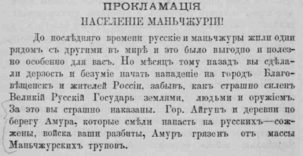1900 Amur anti-Chinese pogroms
Details
| 1900 Amur anti-Chinese Pogroms Gengzi Russian Disaster | |||||||||
|---|---|---|---|---|---|---|---|---|---|
| Part of Russian invasion of Manchuria | |||||||||
 In the Blagoveshchensk massacres, a Qing civilian was tied for execution. | |||||||||
| |||||||||
| Belligerents | |||||||||
|
|
| ||||||||
| Commanders and leaders | |||||||||
|
|
| ||||||||
| Strength | |||||||||
| 36,000 Russian soldiers and Cossacks | 22,000 civilians | ||||||||
| Casualties and losses | |||||||||
| 198 officials died | |||||||||
Sources
1900 Amur anti-Chinese pogroms
Introduction
The 1900 Amur anti-Chinese Pogroms were a series of killings and reprisals of Qing subjects of various ethnicities including Manchus, Daur people, Han in Blagoveshchensk and in the Sixty-Four Villages East of the River in the Amur region during the same time as the spread of the Boxer Rebellion throughout China by Russian authorities, ultimately resulting in thousands of deaths, the loss of residency for Chinese living in the Sixty-Four Villages East of the River, and increased Russian control over the region. The Russian justification for the pogroms were attacks made on Russian infrastructure outside Blagoveshchensk by Chinese Boxers, which was then responded to by Russian force. The pogroms themselves occurred between 4–8 July (Old Style, O.S.; 17–21, New Style or N.S.), 1900.
Name
The name for the killings and reprisals that occurred in Amur is not standardized, and has been referred to by different names over time. The most common Chinese name for the pogroms is the Gengzi Russian Disaster (simplified Chinese: 庚子俄难; traditional Chinese: 庚子俄難; pinyin: Gēngzǐ é nán), but the two most major events in Blagoveshchensk and the Sixty-Four Villages East of the River are referred to as the Blagoveshchensk Massacre (simplified Chinese: 海兰泡惨案; traditional Chinese: 海蘭泡慘案; pinyin: Hǎilánpào cǎn'àn) and the Sixty-Four Villages East of the River Massacre (simplified Chinese: 江东六十四屯惨案; traditional Chinese: 江東六十四屯慘案; pinyin: Jiāngdōng liùshísì tún cǎn'àn) respectively.
The Russian name of the pogroms in Blagoveshchensk is referred to as the Chinese Pogrom in Blagoveshchensk (Russian: Китайский погром в Благовещенске), while the killings and reprisals that took place in the Sixty-Four Villages East of the River are referred to as the Battle on the Amur (Russian: Бои на Амуре).
Background
This section needs expansion. You can help by adding to it. (May 2019) |
Blagoveshchensk was founded on the territory ceded to Russia by Treaty of Aigun in 1858.
Process
Blagoveshchensk
This section is empty. You can help by adding to it. (May 2019) |
Sixty-Four Villages East of the River
Lieutenant-General Konstantin Nikolaevich Gribskiy ordered the expulsion of all Qing subjects who remained north of the river. This included the residents of the villages, and Chinese traders and workers who lived in Blagoveshchensk proper, where they numbered anywhere between one-sixth and one-half of the local population of 30,000. They were taken by the local police and driven into the river to be drowned. Those who could swim were shot by the Russian forces. There were 1,266 households, including 900 Daurs and 4,500 Manchus in the area until the massacre. Many Manchu villages were burned by Cossacks in the massacre according to Victor Zatsepine.
Legacy
Andrew Higgins of The New York Times wrote that Chinese and Russian officials tended to not bring up the incidents during periods of good China-Russia relations or China-Soviet Union relations, while the incident was brought up after the Sino-Soviet split with people still alive who had been in the pogroms being interviewed by Chinese officials. Higgins stated that in 2020 Chinese and Russian officials purposefully avoided dealing with the incident.

